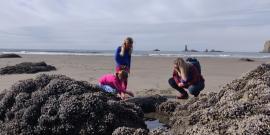
200+ Five-Star Tour Reviews
Reviews for independent small businesses are becoming harder to find organically, so please use these direct links to find Experience Olympic reviews on TripAdvisor, Experience Olympic reviews on Yelp, or find Experience Olympic reviews by setting Google as your search engine and search 'Experience Olympic.'
You can alternatively scroll down to read an amazingly detailed multi-day Olympic Peninsula Birding Tour Review by John.
Birding Private Multi-Day Tour Review by John Stump June 13 - 15
Summing up my Olympic Experience
By all intents and measures, including reasonable rates, this was a most successful venture and shall remain as a model for future birding expectations. I can proudly announce 12 new life birds, many of them endemic to the northwest Pacific coast. This also resulted in a trip list of 77 species, although our goal was to find birds on my target list and not to compile a comprehensive list of all species which might be present.
I should also mention that Carolyn’s conversational ability and extensive knowledge of local history, all things flora and fauna, and a wide range of other subjects added much more to our travels across the Peninsula than her birding expertise alone. As an added bonus, Carolyn also worked patiently with me to memorialize the experience by setting me up on an eBird account.
Preparing for my Olympic Experience
A great opportunity to sample birding and pursue Alcids and other coastal endemics for my life list in the far northwest U.S. came when my wife, Perla, signed up for a 3-day workshop for fiber artists on Washington State’s Whidbey Island north of Seattle. Long overdue for a birding adventure in a very special place, it didn’t take me long to decide to tag along for a birding expedition while she perfected some new felting techniques for wearable art.
Our plans included arrival at the Blue Goose B&B in Coupeville via airport shuttle from Seattle on June 12, my departure for a birding adventure the 13th, and returning to the B&B on June 15 for next day shuttle to Seattle and flight back to Denver with Perla. To make all of this possible in just 3 days, I needed make arrangements ahead of time with a birding professional willing to serve as my personal guide in order to find a dozen or so must-find species.
From a web search of Whidbey and other birding groups I was fortunate to find the perfect guide in Carolyn. She was extremely helpful in assessing the chance of finding various species in the Alcids family (also referred to as auks) which are only found on the Pacific and Atlantic coasts and were entirely missing from my life list. We also discussed other life bird priorities for my June visit by email and telephone, from which Carolyn designed a made-to-order itinerary giving me comfort in knowing we were going to see a good share of about 12 species on my target list.
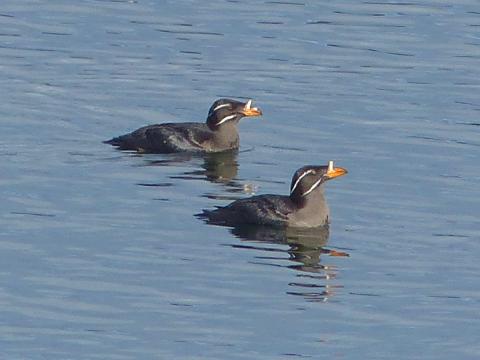
It came as a great relief that I would not have to rent a car since we would be traveling in the Experience Olympic van. I also appreciated Carolyn’s attention to details including keeping track of ferry schedules to and from the mainland, supplying lunches, advising on hotel options in Port Angeles, and making sure the walks and hikes were within my range of physical endurance. Other than a taxi ride from the B&B to the ferry landing and hotel reservation in Port Angeles, I had no further worries.
This was my first time in the Puget Sound and Olympic Peninsula area, which was in itself a great experience for me. The beauty of different trees and flora supported by a wetter climate stood in stark contrast to my high and dry home in the southern Rockies, and temperatures in the 60’s in contrast to the 80’s and 90’s when we left Denver was refreshing. However, I was glad I did bring along a raincoat with a hood, long-sleeved shirts, and a down vest when needed. Carolyn warned me about the wet climate effect on cotton shirts and pants, and I left them at home.
Day 1- June 13
Good thing Carolyn met me at the Townsend-Keystone ferry landing because I needed to learn the ropes on how to pay, negotiate the turnstiles, and access the best viewing platforms. Alcids including Pigeon Guillemot immediately showed up around the docking structures, and soon we began to see small bunches of Rhinoceros Auklet flying and diving in the path of the ferry as it crossed Admiralty Inlet.
Gulls were ever-present in most places throughout our journeys, and included Glaucous-winged, California, and an endemic hybrid Glaucous-winged x Western called the “Olympic Gull” --- good enough for me to lifelist.
Other birds included Pelagic Cormorant dominant over Double-crested, Caspian Tern, Barn and Violet-green Swallows, and a surprise pair of Purple Martins nesting in some metal holes in the landing structures.
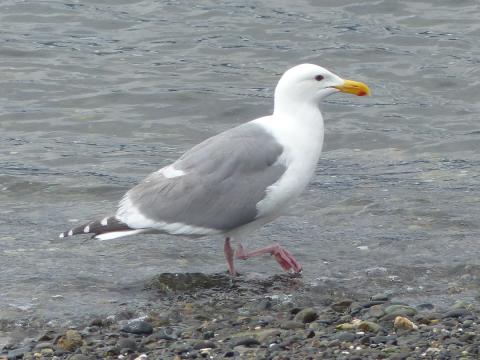
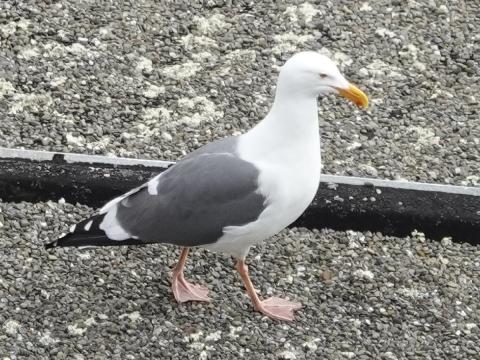
Boarding the company van on arrival in Port Townsend, we ventured west to the Dungeness Recreation Area, a superb birding spot where I found the forest quite different than Colorado with trees much taller, understory much denser, and a greater diversity of plant cover. Barred Owls are present here, and the park supervisor and friend of Carolyn reported one sitting on a fence by the entrance a few minutes before we arrived. Prior to a trip to Florida last year, this was my nemesis bird. Why it shows up in a completely different climate at Dungeness and not a trace of it in the Colorado Rockies is a total mystery to me.
Our main quest here was to find my lifer Pacific Wren, but I was curious about all species we might discover in this unfamiliar habitat, and content to bird by ear. In particular, it was interesting for me to compare the species mix we were finding here with birds back home, and to note any differences between similar species in the coastal forest to those in the Colorado Rockies.
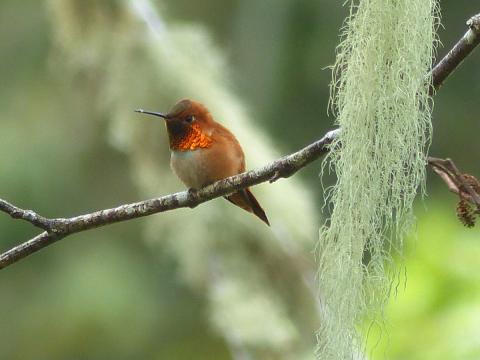
A few selected observations may be worth sharing. I noted Golden-crowned Kinglets dominating the coastal forest canopy vs. Ruby-crowned in my part of the Rockies. In other comparisons Purple Finch replacing Cassin’s; Oregon Junco vs. Gray-headed; Swainson’s Thrush vs. Hermit; Rufous Hummingbird vs. Broad-tailed; and Pacific-slope Flycatcher told apart from its Rocky Mountain cousin by a single note tweet vs a two-syllable tee-SEET in the Cordilleran. Totally unknown to me was a coastal tribe of Hutton’s Vireo identified by Carolyn from call notes and only seen before by me in New Mexico.
Song variations also distinguished coastal sub-species from the interior including different songs from Spotted Towhee, Wilson’s Warbler, and other warblers. It was also nice to see Chestnut-backed Chickadee close-up, and California Quail. Other birds were the same in all respects but totally at home in completely different settings such as Savannah Sparrow, White-crowned Sparrow, American Goldfinch, Bushtit, Orange-crowned Warbler, and Common Yellowthroat.
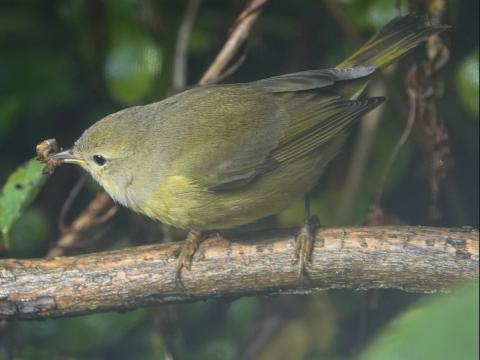
Pacific Wren, split from the more interior Winter Wren, was identified by its totally un-wrenlike series of high-pitched squeaks and song snipets. They were fairly common here and close to the trail, but near impossible to see. Not content with a heard confirmation, I was finally able to make one out as an apple-sized brown bouncing ball hopping down from a tree branch. Quite a contrast to a House Wren in the cottonwoods back home performing its territorial song with an operatic flare and in full view.
Further on to Salt Creek County Park, Carolyn knew I would tally my life bird Harlequin Duck which was high on my wishlist, and I could not have imagined having such a dazzling view. After getting my fill of the Harlequins, we moved on to Port Angeles where I was given several price options for two night’s lodging. I do not regret reserving a second-floor room at the Red Lion Inn facing the Strait of Juan de Fuca in a classic harbor setting complete with active shipping port. A resident flock of Surf Scoters cruising the protected harbor waters was an added bonus.
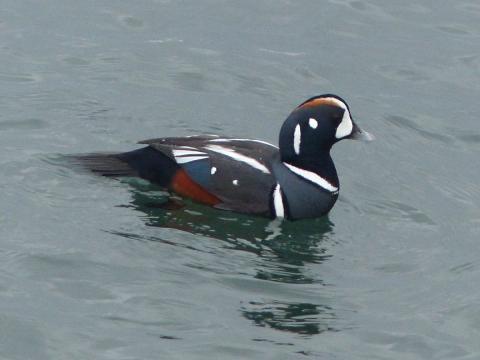
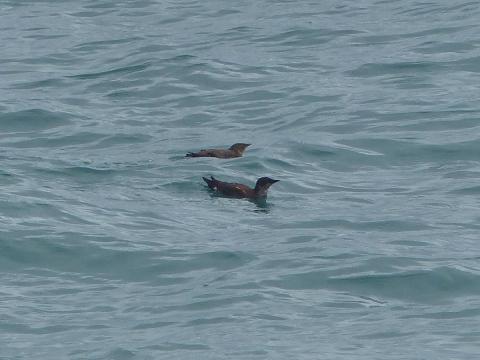
After some R&R time at the hotel, Carolyn returned in the evening for some good looks in the Cherry Street neighborhood of Port Angeles for Vaux’s Swift, which I missed on a California trip years ago. Still with plenty of evening light, we proceeded to a miles-long jetty called Ediz Hook separating the harbor from open waters. Here we saw a large numbers of gulls, Great Blue Herons, and other water birds settling in for the night, and Carolyn helped me focus in on two tiny Marbled Murrelets as lifers on the windy side along with a Red-throated Loon.
Day 2 - June 14
Very early next morning it was time for the long ride to Neah Bay and Cape Flattery at the far west end of the peninsula bordering the Pacific Ocean, marking the northwest-most point of land in the continuous 48 states. All of this area is part of a reservation managed by the Makah Indian tribe and is truly a birding Mecca. On our way there, we passed through the Wa’ atch River Valley with some open areas bordering the forest where flocks of unexpected Black Swifts were feeding on an insect hatch.
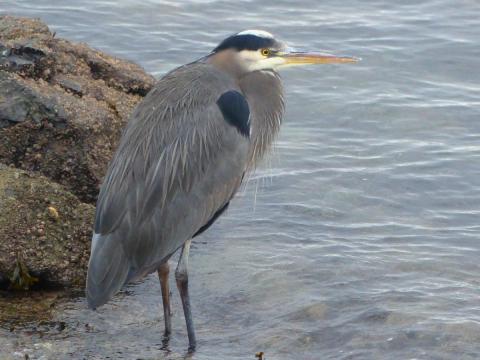
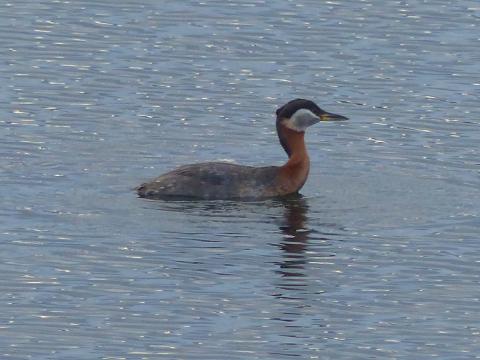
Finding a calm day at the Neah Bay village harbor, Carolyn set up the scope at a beachside vantage point and was able to sort out White-winged Scoter and Red-necked Grebe --- two species which avoided me on other occasions and were added to my life list. Carolyn also assured me I could safely count the visibly smaller crows passing by under the watchful eyes of Bald Eagles as Northwestern Crow. The shores of Neah Bay village also produced other species including Common Loon and Barrow’s Goldeneye.
Egos high with three lifers so early on, there would be much more to come and we moved on to keep our appointment with Cape Flattery. Numerous Robins with some Varied Thrushes mixed in were spooking up along the road to the parking area and trailhead. The trail fortified by carefully placed wooden steps required a walking stick and descended a half mile or so ending up on a shelf protruding out over the ocean. Although I am several or more decades her senior, I am always up for the rigors of birding, and I assured Carolyn this was no challenge at all compared with trails encountered on past birding trips to Peru and Ecuador.
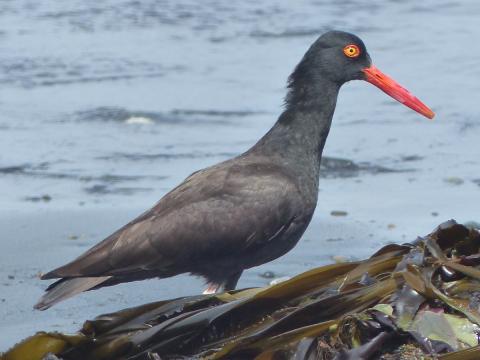
The scene from our safe and comfortable perch above the Pacific at the Cape overlook was something out of National Geographic, and the highlight of my birding trip. The cliffs and rock fissures surrounding us were teeming with nesting colonies of seabirds, dominated by the echoing squawks of Pelagic Cormorants from their nests deep in the rock ledges. Far off a half-mile or so was Totoosh Island protecting an even bigger colony of nesters and more species diversity.
With the scope trained on the choppy waters off Tatoosh, Carolyn spotted a raft of Common Murres as my next lifer, and she soon had some distance views of Tufted Puffins on the rocks. Needless to say I was ecstatic about what I considered the best bird of my trip, but as we munched custom-prepared sandwiches from the stash in Carolyn’s backpack I spotted a pair of Tufted Puffins directly below us among a covey of Pigeon Guillemots. Seeing the Puffin behavior at fairly close quarters demonstrated to me just how closely the Alcid family was filling an ecological niche similar to Penguins in the Southern Hemisphere.
Marine mammals also began to appear. No Gray Whales today, but a family of Sea Otters was entertaining to watch, and we also saw a Harbor Seal and a distant Steller’s Sea Lion on Tatoosh. Satisfied we had seen most species, we trekked up the stairway to the van and traced our route back on the tree-lined highways to Port Angeles. Carolyn dropped me off at the Red Lion for an evening of relaxation, some excellent local crab and seafood at the Kokopelli, and a good night’s sleep for my last day of birding tomorrow.
Day 3 - June 15
Thanks to Carolyn and her professional guiding ability, I now had 12 life birds representing all but Sooty Grouse on my target list. I checked out of the Red Lion and met Carolyn with the van at 5:00 AM for our grouse quest in the mountainous terrain of Hurricane Ridge in the Olympic National Park just south of Port Angeles. Landscape here was heavily forested and reminded me of places back home in the Rio Grande Forest before the beetles and fire, but was much denser, steeper, and less rocky. Forest birds at elevation in the much wetter Olympic habitat was home to Townsend’s Warbler --- a fall migrant in Colorado. A few of the species found here same as Colorado included Western Tanager, Black-headed Grosbeak, and Hammond’s Flycatcher.
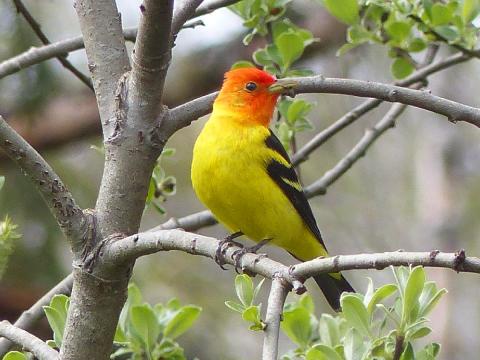
As we proceeded on the drive up the ridge it began to look more and more like prime grouse cover, and we expected one to pop up at any minute. But story short, the scenery was spectacular and I wouldn’t have missed this leg of the trip for anything, but Carolyn had warned me that we were gambling on the chance of finding our target bird at a time of year when grouse are nesting and not as frequent along the road. I am also familiar with the random and unpredictable nature of the Sooty’s Dusky Grouse cousin in the Rockies, and totally empathetic to the challenges of our quest.
We headed all the way up to the historic visitor center at the top of the ridge where patches of snow still remained. On the way back down we stopped at Morse Creek Overlook where Carolyn spotted flocks of Band-tailed Pigeons moving higher up on the mountainsides --- always a nice find. Not finding the grouse in no way compromised our success on this 3-day trip with other species including 5 Alcids, and I was looking forward to exploring more of Carolyn’s birding spots near Sequim and other areas on the way back east to Port Townsend.

At Dungeness Landing Park, where the Dungeness River meets the bay next to private land, large numbers of Great Blue Herons were gathering on a sand spit out in the bay, and a passing flock of Caspian Terns filled the sky with birds. A place like this could always produce some unexpected results, and that’s exactly what happened when we finally noticed a small group of Whimbrels feeding close by in the mudflats.
Another birdy spot in the same area called Three Crabs gave us a different vantage point with plovers and Gadwalls. While Mallards are numerous in my home in the San Luis Valley of Colorado, one would expect to find some here along with the Gadwalls as well, but we never saw a single one on our Peninsula journeys. Scope views of the distant bunch of plovers revealed one Black-bellied Plover, but the rest were not distinguishable or in transitional plumage, giving us some speculation about Golden Plover.
Arriving at the ferry landing back in Port Townsend, we were greeted with strong winds and rough seas. Fortunately, we were told the ferry would proceed on schedule, and my great 3-day birding adventure was coming to an end. Again I appreciated Carolyn’s assistance on the ferry boarding, and expressed my sincere thanks and gratitude for all her careful planning, fabulous company, and ability to give personal attention to all my birding targets.
During its passage across this neck of Puget Sound from Port Townsend to the Keystone landing, the ferry plowed through rough seas without a tilt and I watched flock after flock of Rhinoceros Auklets from windows inside the main cabin foredeck. Back on shore I had a cab waiting for me for the 4 miles to the B&B, where I teamed up with Perla for a great dinner at the Ciao across the street and flight to DIA next day.
Carolyn just started ebirding in earnest in 2017, the year John wrote this amazingly detailed tour review.
Figure out what your Target Species for the Olympic Peninsula are on eBird and contact us to plan a private guided birding tour or consider our multi-day birding tour package.
